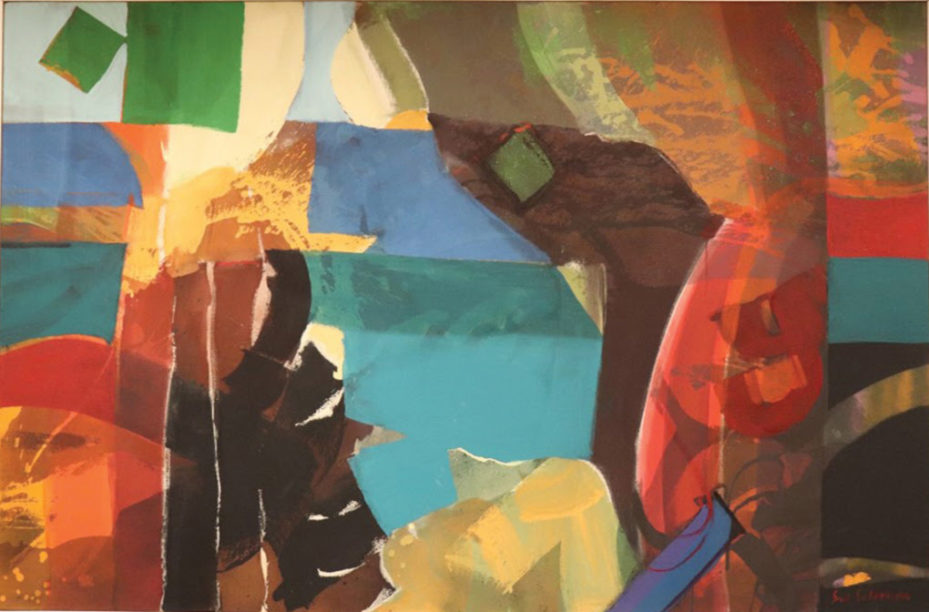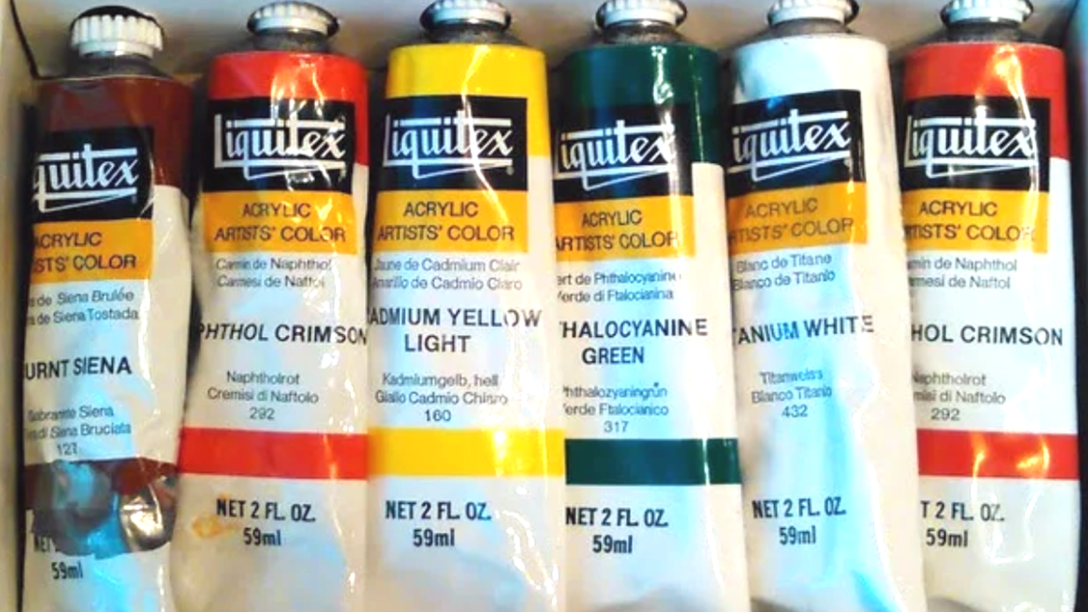The fixture of color in a permanent physical medium, whether paint, ink or dye, has posed a persistent problem throughout history. For every prehistoric cave painting that survived in Sulawesi or Lascaux, innumerable masterpieces faded irretrievably, beyond the reach of memory. Sunlight and heat, dirt and moisture continue to threaten the color of every brushstroke that remains to us. But while inks and watercolors, and the esoteric oils and temperas of the old masters, must be hidden away from the sun, acrylics outlast them all, cheating entropy and dazzling us in their chemical perpetuity. I at least have never seen a red as robust as Liquitex acrylic, a depthless, vermilion abyss forever suspended in every art-store tube.
Red features prominently in the works of Syd Solomon, popularly acknowledged “as the first artist to use acrylic paint.” Solomon would never ascend to the fame of Pollock or Warhol, but he built up a name for himself, as well as a wide network spanning his seasonal retreats in the Hamptons and Sarasota, Florida. It was in the latter resort town that I once guarded his work in a museum. I developed a special fondness for his his vibrant palette and wavelike brushstrokes, which captured a certain explosive quality in Florida’s coastal light.
At every level, the sheer excellence of acrylic paints is dizzying. They dry quickly, they hold color well, and best of all, they’re cheap, uniting many miracles of our global petroculture. It’s all too easy to gloss over the genuinely supernatural properties of fossil fuels. I don’t mean to say “hey let’s celebrate a system of dependency that damns the millions least responsible,” but without some honest assessment of the intrinsic ecstasies of petroleum, our historical moment is just unintelligible.
The 1987 Kurt Vonnegut novel Bluebeard is the story of Rabo Karabekian, a failed artist and the owner of “the most important collection of Abstract Expressionist paintings still in private hands.” In the novel Karabekian reflects, “Since I have done no useful work for decades, what else am I, really, but a museum guard?” The character is based in part on Syd Solomon, who was a close friend of Vonnegut’s beginning in the late 1960s. In particular, Solomon’s experiences as a WWII specialist in camouflage reemerge as Karabekian’s in the novel. (In 2000 Vonnegut wrote to Solomon’s wife, praising “Syd’s silver tongue”: “I committed plagiarism on a grand scale!” he wrote. “BLUEBEARD had everything but originality.”)

I began my own stint as an art museum guard about eight months into the pandemic, a period I now fondly recall as Covid-classic—pre-vaccine, pre-variants—and quite possibly the last, distant marker of anything approaching political consensus in Florida. I didn’t hold the job long, spending a matter of months working alongside some true downhome sweethearts, and the most deadeyed busybodies imaginable. But I did become intimately acquainted with the museum’s stunning collection of the works of Solomon, a neglected genius of abstract art in America.
One of the collection’s standouts, based on an aquatic scene from the 1961 documentary Silent World by oceanographer Jacques Cousteau, checkers a cascade of oceanic blue-greens and sunlit yellows against blasts of red, poking out in half-concealed bursts. Amidst the flurry of other colors, red appears here as background, brief hints of a scarlet canvas beneath the colors of the sea.
Stratalure and Duality, a pair of canvases from 1980, are likewise representative of Solomon’s striking use of red. The first centers on a prismatic wave with red at its heart, radiating out against a dusky background accompanied by a sudden surge of seafoam. The red pulls the ribbons of color from the margins across the second canvas, contrasting shadow boxes rippled with inky black.
Solomon’s reds sketch out the dynamism that unfolds daily along the Gulf Coast, breaking with an otherwise naturalistic colorscape to draw the viewer into the scene. The artifice of these acrylic reds captures something of the strain of seeing in a starkly lit Florida evening, like an optometrist’s flashlight exposing the blood vessels of the eye. They stamp his work with the afterimage of seeing, the momentum of vision focusing and refocusing as fading light flashes across towering thunderheads or the twilit ripples of the Sarasota Bay. Half-covered reds flare out against other details, stretching the palette into the simmering tension at the heart of Solomon’s practice.
Considering its fossil origin and the chemical afterlife acrylic paints leave behind, the eerie vibrance of red is a fitting hue for acrylic. It’s a sort of coral snake color, a warning light I imagine lining the interior of each plasticine glob. The standard red acrylic makes no allusions to life. It’s not oxblood, not ochre, not poppy red, but the stuff of fire engines, Red Flyer wagons, and stop signs.
And so I wonder what Syd Solomon saw in his reds.
Some of his earliest archived sketches, made on the European front during World War II, are entirely drained of color, showing shadowy battlefields and the broken bodies of German soldiers. He would later claim that his experience in aerial deception as a camoufleur—looking down at the patchwork countryside his designs would mimic—informed his opinions on abstract painting. The overlapping perspectives of his work, and especially his application of red, embody a floating, aerial effervescence, simultaneously refracted, vital and direct.
I suspect that any honest judgments of Solomon that Bluebeard may contain are equally applicable to Vonnegut himself. It was one of his last novels, written after his own star had somewhat faded. Unable to churn out back-to-back hits like Cat’s Cradle and Slaughterhouse 5, Bluebeard channels Vonnegut’s characteristic cynicism into a life of fallen fame and meaningless wealth. It breaks with the deterministic undertones of his prior fiction, and is one of few contemporary works to engage directly with the machismo of the postwar creative milieu. Yet Vonnegut’s portrait of the artist is self-loathing to the hilt. Bluebeard contains this assessment: “What will be found written after the name of Rabo Karabekian in the Big Book on Judgement Day? ‘Soldier: Excellent.’ ‘Husband and Father: Floparroo.’ ‘Serious artist: Floparroo.’”
In the part of Bluebeard that most recalls the struggles of the real Syd Solomon, Vonnegut substitutes the medium for the message: Karabekian’s reputation as an artist is ruined because “unforeseen chemical reactions” between the canvas and his paint of choice, the fictional acrylic Sateen Dura-Luxe, cause the paintings to pull themselves apart. Though none of Solomon’s real works shared this fate, the story is an allegory, not only of both men’s professional disappointments, but of Solomon’s famous residence.
In the late 60s, Solomon commissioned the architect Gene Leedy, a founder of the so-called Sarasota School of modern architecture, to build a combined house and studio on the southern end of Siesta Key, a barrier island that encloses the Sarasota Bay. It was a stunning construction of prestressed concrete and cantilevered balconies overlooking the water, and Solomon purchased the surrounding land in the hopes of founding an artists’ colony there. But within 13 years of completion, owing in part to the artificial deepening of the surrounding waterways, the shape of Siesta Key’s south end would shift, threatening the beautiful structure. With the permission of the state governor and county officials, Solomon ordered the pass between the Siesta and the neighboring Casey Key bulldozed shut to protect his home from further erosion. Though the interference bought some time, by 2003 the house had been abandoned and demolished. Solomon passed away a year later, and the pass still remains closed.
For many Sarasotans, the closure of the pass is Solomon’s most enduring legacy. It would ignite a controversy in local politics that persists to this day, a pantomime of the endless predations we can or cannot justify along the Gulf Coast. Long before I ever guarded Solomon’s art, I mourned for the pass and listened to pained soliloquies about the water turned turgid and the habitats destroyed.
Rabo Karabekian was drawn to Sateen Dura-Luxe because its advertising promised that it would “outlive the smile on the Mona Lisa,” a feat that the acrylics of Syd Solomon will almost certainly achieve. Had he built his house just a mile away, on the inland shore of the bay, perhaps that too would have survived. The ground is high and firm, hosting the homes of early European pioneers, perched atop of a complex of middens and burial mounds built by the shore’s Indigenous people over thousands of years.
Many of the mounds that once dotted the Gulf Coast are long since desecrated, taken apart in the early 20th century to pave the streets with bleached seashell in a style that is still mimicked in footpaths today. I saw the cross-section of an associated midden once, its swirling mixture of ash, shell, and ceramic arranged in a manner not all that unlike the compositions of Syd Solomon.

The chemical residue of the mass media he pioneered will make up the middens of our own historical moment, but I can’t help but appreciate Solomon’s art. Through flat canvases he encased whole sunsets in a chemical amber, enfolding the energy of light and color in taut, depthless worlds, frame after frame. I have to hope that there is some small modicum of beauty that will outlast our dependence on petrochemicals, as a promise to all our descendants that all of this wasn’t just because we could. Solomon invited us to see red, coloring in all the tension of our current contradictions.






